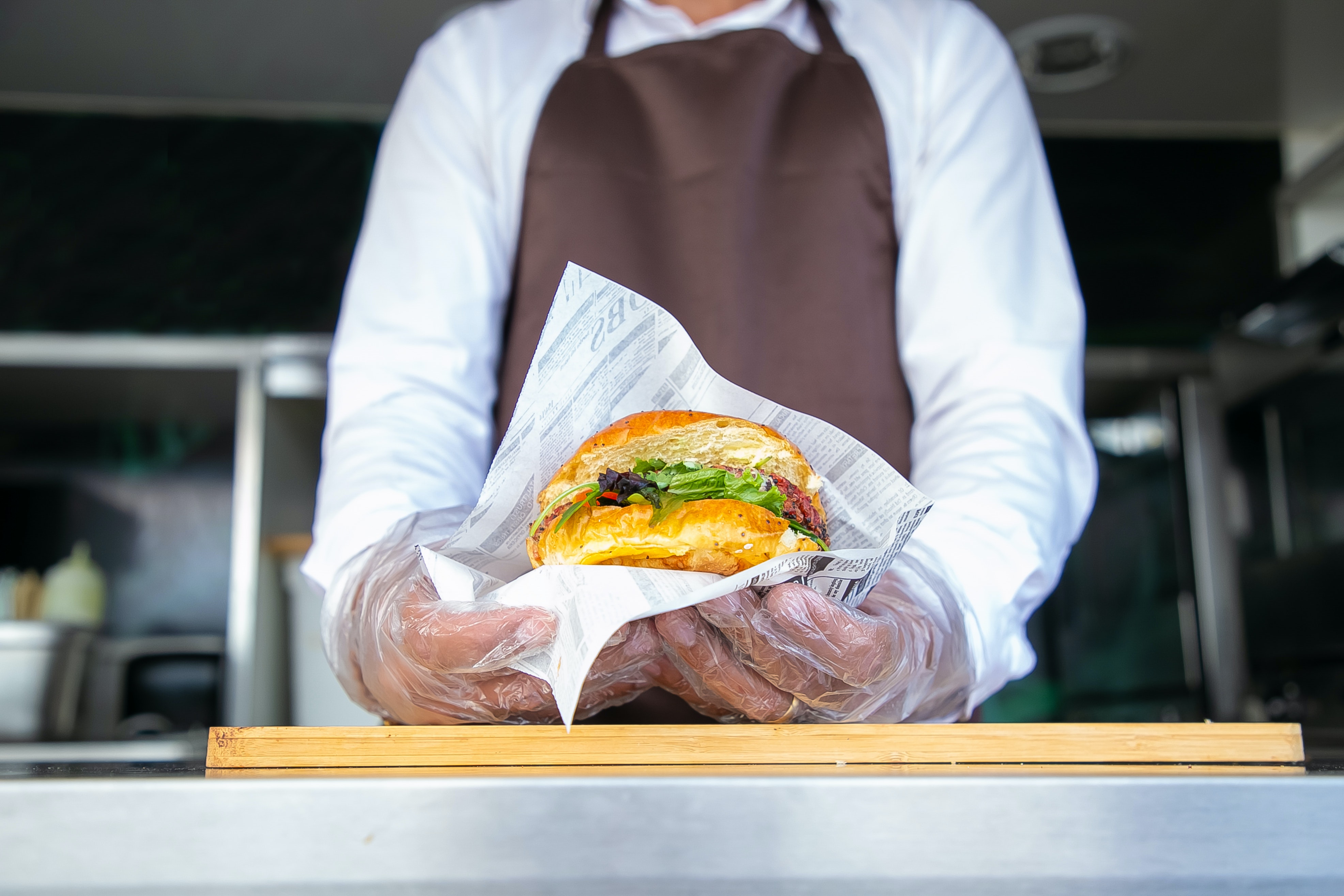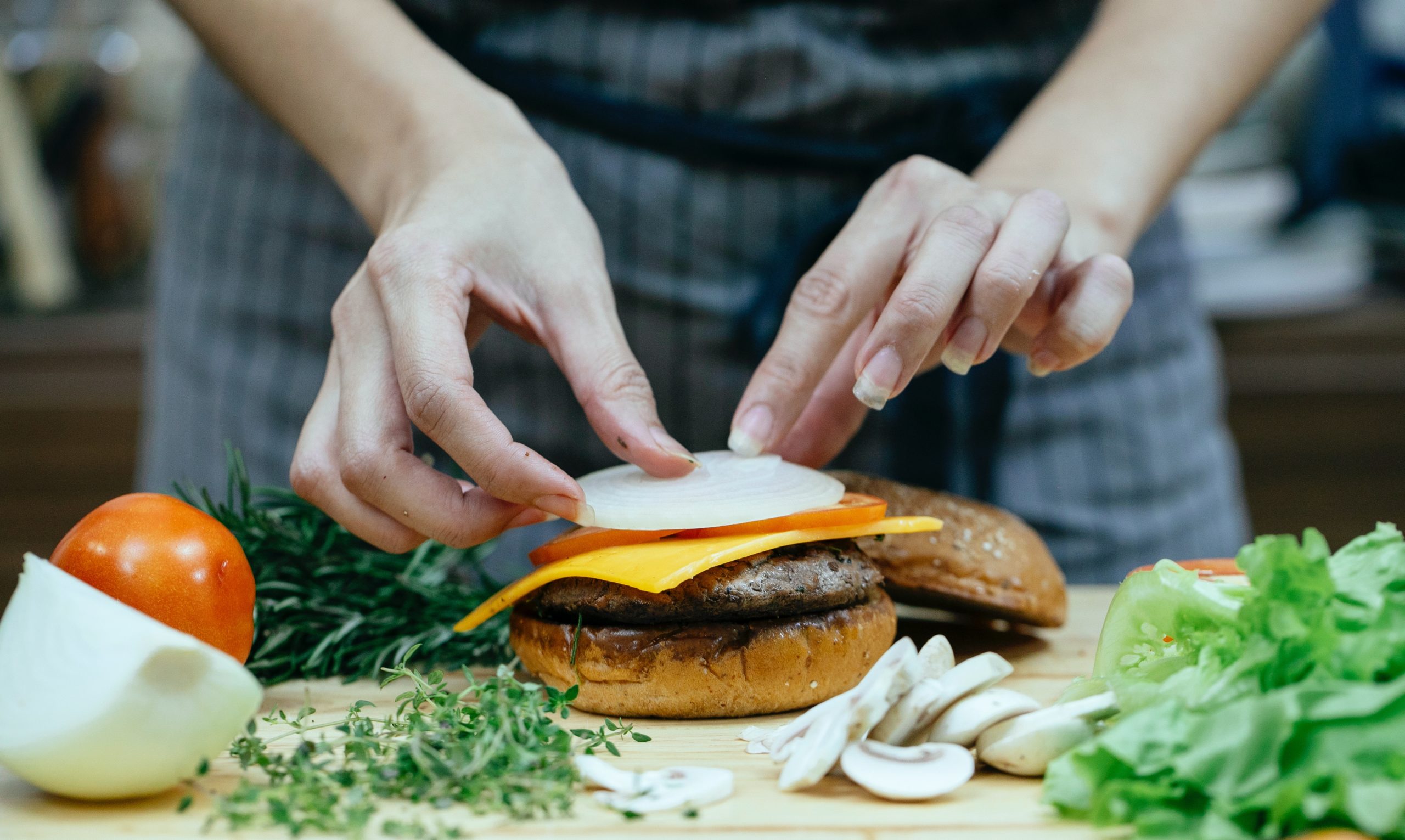Once we learned How to Cook Burgers on the Stove, it became our go-to easy dinner for any time of year. This is a great way to ensure that every time you cook cheeseburgers, they come out juicy and perfect. With this recipe, you can make the best burgers any time of year.
How to Make Pan-Fried Burgers on the Stove?
Ingredients
- 1-1/3 pounds of ground beef
- Kosher salt and pepper, to taste
- Four tablespoons of unsalted butter, softened, plus extra for the pan
- Four hamburger buns
- 4 slices melty cheese, optional
- Burger toppings, optional
Tips for Cooking Perfect Stovetop Burgers
Use a flat pan over medium-high heat to cook your burgers. When you drop the patties into the pan, they should sizzle, and when you flip them, you should see a nice dark, golden-brown sear. That’s how you know a burger is good.
Also, the best way to flip a burger is with a wide, thin spatula. This lets you quickly slide under the burger and flip it without ruining the crust you just made. It also keeps these burgers from falling apart when you flip them. (But if they break, press the pieces back together and keep going; if you put cheese on top, no one will ever know.)
Directions
Step 1: Divide the Beef and Shape the Patties
Run your hands under cold water and divide the beef with no seasonings into four equal parts. Roll each piece into a ball with your hands. Flatten the ball until you have a disc that is 1 inch thick and uniform. Then, make a hole in the middle of each patty with your thumb. Move quickly through this step to keep the beef as cold as possible.
Step 2: Preheat the Pan
Put the patties in the fridge while you heat a skillet made of cast iron or stainless steel over medium-high heat. The fat won’t melt until it hits the hot pan because it will be cold. It will also help your burger get a nice sear and a lightly crispy outside without overcooking the inside.
Step 3: Toast the Buns
Spread 1/2 tablespoon of butter on the top and bottom buns and place them on the hot skillet, butter-side down. After about a minute, they will be toasty and golden brown. Take them off and put them on a plate. Use a towel to remove any bread crumbs from the pan, then put it back on the Stove over medium-high heat.
Step 4: Cook the Burgers
When the pan is almost smoking, put a lot of salt on both sides of each burger patty. Add a pat of butter to the pan and swirl it around until it’s well coated. This will keep the patties from sticking and give them a nice sear. Put the patties in the pan, leaving space between them so they can cook evenly. You may have to do it in parts. Cook the burgers for 3–4 minutes, or until the bottom side is nicely browned.
Flip the burgers over with a wide, thin spatula and cook them for another 3 to 4 minutes, or until they reach the temperature you want on the inside.
Step 5: Get Cheesy
Take the pan off the heat and give each burger a slice of cheese. Put a lid on the pan so the cheese can melt while you make the buns.
Step 6: Garnish and Serve
Spread a thin layer of mayonnaise on the bottom bun to keep burger juices from making the bread soggy. Put a burger patty on the bottom bun and top it with your favorite toppings.
How Long to Pan-Fry Burgers?
Here’s a guide for the cook time and temperature of 1-in. burger patties:
Medium-rare (warm and red in the middle): 6 minutes (130 to 135°)
Medium (warm and pink in the middle): 7–8 minutes or 140–145°
Medium-well (center is hot and a little pink): 9 minutes, or 150 to 155°
Well done (brown all the way): 10 minutes, or 160 to 165°F.
How Long to Cook Burgers for Medium Rare Stovetop Burgers?
This is the easiest and safest way to ensure that your burgers are always cooked just right. Here are the cooking times for burgers that are about an inch thick and are cooked over medium-high heat:
Medium Rare (red in the middle): 6 minutes total (3 minutes on each side)
Medium (pink in the middle): 7-8 minutes total9 minutes total
Medium Well (a smidge of pink in the middle): 9 minutes total
Well Done (no pink):10 minutes total
What do you Serve with Stovetop Burgers?
When we finally figured out how to make burgers on the Stove, I knew we also needed the right sides. We love to serve these juicy cheeseburgers made on the Stove with a few of our favorite sides.
- Shoestring Fries
- Avocado Fries
- Baked Sweet Potato Chips
- Boiled Corn on the Cob
- BBQ Baked Beans Casserole
- Creamy Coleslaw
- Sweet Potato Fries
Do you Need Oil to Cook Burgers on the Stove?
In a ceramic or nonstick pan, you can cook burgers without oil, but the patties will dry out and cook unevenly if you do. Instead, add a small amount of cooking oil to the pan and rub it on the surface with a paper towel before you heat it.
In a ceramic or nonstick pan, you can cook burgers without oil, but the patties will dry out and cook unevenly if you do. Instead, add a small amount of cooking oil to the pan and rub it on the surface with a paper towel before you heat it. Cookware experts call the layer of burned-on oil and fat on a well-used cast iron or carbon steel skillet “patina.” This patina will keep the burger meat from sticking to the pan by making a layer between the meat and the pan.
People who cook with stainless steel or copper should put one tablespoon of vegetable oil in their pans and use a paper towel to spread it on the bottom and sides. This makes a barrier between the “sticky” patty and the bare steel surface of the pan, so the meat doesn’t stick as much when it’s shallow-fried.
What Kind of Pan is Best for Burgers?
When making burgers at home, the pan you use is almost as important as the meat you choose and the oil you use. First, don’t try to cook your burgers in a pan that doesn’t stick. PTFE or ceramic coatings on nonstick cookware can’t produce the browning you can get with bare metal pans.
The best pan is cast iron, carbon steel, or clad stainless steel with a thick, heavy bottom for pan-frying a burger. This pan heats up quickly and keeps heat for a long time, making crisp and evenly browned patties. You can also sear and grill meat in copper pans on your Stove.
What’s the Best Oil for Cooking Burgers?
All the oils and fats you can buy at the store fall into two groups: those with a low smoke point or those with a high smoke point.
Low smoke point oils and fats are best for dressing salads, marinating meat, adding to bread and pizza doughs, and cooking over low to medium heat. This is where butter fits in. High smoke point oils and fats are best for cooking at medium-high heat, like searing, sautéing, and deep-frying (and, in rare cases, high heat).
We cook burgers over medium-high heat, which is between 375°F and 450°F (190.5°C and 232.2°C).
Use a cooking oil with a high smoke point when making burgers in a pan on the Stove. Medium-high heat makes it easy to heat butter and other delicate oils and fats past their smoke point when cooking. Avocado oil, corn oil, sunflower oil, and rice bran oil are some of the best cooking oils for the job.
Are Burgers Better on the Stove or Oven?
Baked burgers are great because you don’t have to do much to make them, and your kitchen won’t smell like fried beef. On the other hand, burgers that are pan-fried get a tasty sear from the cast-iron pan. And if it’s hot outside, cooking burgers on the Stove will not heat your house as much as baking them. You can bake hamburgers in the oven to make a tasty meal.
It’s easy to make and a great alternative to cooking for a large group on game day. You’ll make it again and again. The easiest way to cook burgers is to bake them in the oven. Press the spiced ground beef into the pan and bake at 400°F for about 15 minutes. Once the meat is done, you can add some cheese, cut it into squares, and serve! It’s a lot easier than cooking in a pan.
Conclusion
Most places don’t let you grill burgers all year long, but with a Stovetop Burger, you can have a juicy, pan-cooked burger any day of the year! One of the best burgers you’ll ever eat is made from deliciously seasoned meat shaped into patties and cooked to perfection on the Stove. Then, melty cheese is put on top of the patties. Burgers can be a good source of protein, vitamins, and minerals like iron, B12, and zinc, which help make DNA and keep the immune system strong.

